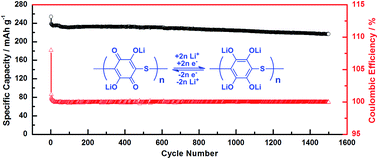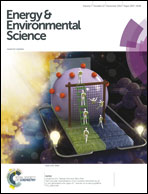A quinone-based oligomeric lithium salt for superior Li–organic batteries†
Abstract
Organic electrode materials are promising alternatives to transition-metal based intercalation compounds for the next generation of high-performance and sustainable batteries. Herein, a novel quinone-based organic, lithium salt of poly(2,5-dihydroxy-p-benzoquinonyl sulfide) (Li2PDHBQS), was successfully synthesized through a simple one-step polycondensation reaction, and applied as a cathode for Li–organic batteries. As an oligomeric lithium salt with average polymerization degree of 7, Li2PDHBQS combines the advantages of the O⋯Li⋯O coordination bond and increased molecular weight, thus solves absolutely the dissolution problem of active material in non-aqueous electrolytes, which has seriously hindered development of organic electrode materials. Benefiting from the high theoretical capacity, intrinsic insolubility, fast reaction kinetics of the quinone group, accelerated Li-ion transport and uniform blending with conductive carbon, as well as the stable amorphous structure, Li2PDHBQS shows superior comprehensive electrochemical performance including high reversible capacity (268 mA h g−1), high cycling stability (1500 cycles, 90%), high rate capability (5000 mA g−1, 83%) and high Coulombic efficiency (99.9–100.1%). Investigation of the structure–property relationship of Li2PDHBQS and its analogues also gives new insights into developing novel quinone-based organic electrode materials, for building better Li–organic or Na–organic batteries beyond traditional Li-ion batteries.



 Please wait while we load your content...
Please wait while we load your content...